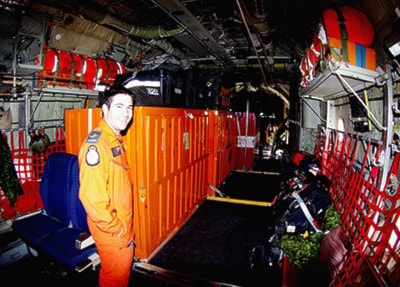A large and prestigious military aircraft touched down on the tarmac at the South Cariboo (108 Mile) Regional Airport on June 12.
There were 13 crew members aboard the CC-130 Hercules #333, who dropped in for a hamburger and french fries lunch at the 108 Golf Resort.
Airport manager Nick Christianson says when he received the initial request to host the huge aircraft, he wasn't sure it could safely land on the 5,000-foot landing strip.
"They are quite a lot larger than the Buffalo [military aircraft], which is maybe half that size. So it has much more capability, and much more endurance time."
In his decade as manager, he's never seen a Hercules with a wing span of 133-feet set down at the airport, where he notes the airstrip is just 75-feet wide.
However, the aircraft also has a Short Takeoff and Landing (STOL) capability to operate on as little as a 3,000-foot landing strip, so Christianson adds the airport has more than enough runway.
When arranging the visit, Flight Commander Major Dennis Scharf told him he'd landed there in a Hercules 15 years ago, the airport manager says, so they went ahead with the landing, and all went smoothly.
"I wasn't sure we could fit a 155,000-pound aircraft into our runway, but it's obviously made for it, and it is nice to know we have that capability in case of disaster. It can move huge amounts of equipment and people really quickly.
"If you take most of the big rescues done across Canada, it's always the Hercules. That is the workhorse they have for [this purpose]."
The top of the tail reaches almost 40 feet high, he says, adding it is "just an amazing aircraft.
"It was nice to have them here, it really was."
Christianson explains the Hercules drew quite a crowd of amazed onlookers from around the community, and others phoned in to ask what the unusually loud, rumbling takeoff was all about.
The 54,000-litre fuel tank holds double the volume the airport carries, but since the aircraft has such a long range, he notes there was plenty of fuel on site to top it up, which "definitely helps" the airport.
Stationed at 435 Squadron in Winnipeg, Man., the crew was flying the older 1973 Hercules to its new posting in British Columbia, Christianson says.
He adds these older, four-engine fixed-wing turboprop aircraft are refurbished as needed by the Royal Canadian Air Force to keep them ship-shape for flight missions.
It will continue its service as one of 17 Royal Canadian Air Force (RCAF) CC-130 Hercules aircraft, but now in Western Canada, Christianson explains.
En route, it performed Search and Rescue Technicians (SAR Tech), pilot and navigator mountain training over Kamloops and Lillooet, he notes, including the SAR Techs parachuting into rugged terrain not available on the prairies.
This Hercules can carry up to 78 combat troops, but is primarily used for search and rescue (SAR) missions.
It is also equipped with the new 406 Emergency Locator Transmitter (ELT) tracking devices, he adds, for picking up signals from downed aircraft or personal locator beacons.
RCAF SAR Techs are members of elite, highly-trained rescue specialist teams that provide on-scene medical aid and evacuation all over Canada, regardless of the conditions.
The 435 Squadron also supports SAR units in the United States, and recently participated in a joint mission over Lake Superior.
Their regular patrols range from the B.C.-Alberta border to Thunder Bay, and from the U.S. border to the North Pole.
Hercules aircraft are also used for a wide range of other RCAF missions, including troop transport, tactical cargo airlift (including vehicles), air-to-air refuelling (AAR) and aircrew training.
It carries 6,200 lbs. in its own fuel and can hold another 38,000 lbs. of fuel in its supply tanks for tactical AAR.
They are so large and cumbersome, Christianson notes they take up a bit of time and a lot of tarmac, so for small, but busy airports, it can create an obstacle smack in the middle of the action.
However, the military's aircraft are always warmly welcomed on the landing strip at 108 Mile Ranch, he explains, and the crews seem to appreciate and enjoy that.
"They are now going to be coming up a little more often. Major [Scharf] said they'd definitely be back, they were quite pleased."
With files from Chris Nickless.
